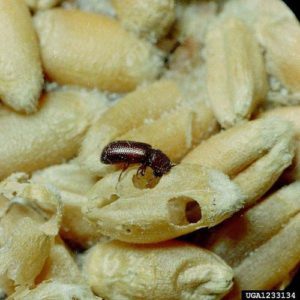 Lesser grain borers are characterized as both an internal and external feeder. They are primarily found in stored wheat and corn. Both the adults and larvae will bore into undamaged kernels of grain and reduce them to nothing more than a hollow husk. However, other products that they can also infest include:
Lesser grain borers are characterized as both an internal and external feeder. They are primarily found in stored wheat and corn. Both the adults and larvae will bore into undamaged kernels of grain and reduce them to nothing more than a hollow husk. However, other products that they can also infest include:
- Tobacco
- Nuts
- Beans
- Bird seed
- Biscuits
- Cassava
- Cocoa beans
- Dried fruits
- Peanuts
- Spices
- Rodenticide baits
- Dried meat and fish
Characteristics
Adults
Adults are:
- 1/13 to 1/8 inches long
- Have a dark brown to black color
- Head is hidden by prothorax (viewed from above)
- Prothorax is slightly knobby and pitted
- Elytra (hard, shell-like forewing) contains distinct rows of pits running their length
- Antennae have 10 segments with the last 3 enlarged, forming a loosely segmented club
Larvae
Larvae are:
- White in color
- Have stout bodies
- C-shaped body
Biology
Lesser grain borer females will lay eggs in groups of up to 30 or singly. She will lay the eggs either on the outside of the grain or within the fine powdered grain that is associated with this type of infestation. During her lifetime a female lesser grain borer can lay between 200 to 500 eggs. The larvae will pupate within the hollow shell of the seed or in the powder that has accumulated. Their development from egg to adult depends on the temperature. On average, their lifecycle will take about 58 days, but under warmer conditions it can take as few as 30 days.




